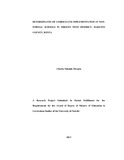Determinants of curriculum implementation in nonformal schools in Mbooni west district, Makueni County, Kenya
Abstract
This study was an assessment of determinants of curriculum implementation
in non-formal schools in Mbooni West District Makueni. Despite the
importance of curriculum in both Formal and non-formal schools (NFS) a
problem has been noted as far as implementation of the curriculum is
concerned. Statistics indicate that only a handful of NFS’s and centers are
using the NFE curriculum. The objectives were to establish the adequacy of
teachers competency on curriculum implementation, to establish the adequacy
of physical facilities on curriculum implementation, to establish the adequacy
of resources on the curriculum implementation and to establish the adequacy
of community participation on the curriculum implementation. The study
adopted a descriptive survey research which involved selecting a sample from
the population and on that basis inferences are made about the population from
which it is drawn. The population was 800 units and the sample size was 80
participants. A census of head teachers was used while upper and lower class
teachers were sampled randomly. The students were chosen using purposive
sampling. Specifically, a student representative (head-boy or head-girl) were
used purposely because they are expected to be more informed than other
students. A student from each school was included in the sample, hence 20
students.This study used a questionnaire for data collection. The specific
descriptive statistics to be used included mean scores and percentages
frequencies. Results indicated that teacher’s competency affects curriculum
implementation. The correlation between teacher’s competency and
curriculum implementation was also found to be positive. Results indicate that
poor physical facilities lead to low curriculum implementation. Findings show
that correlation between curriculum implementation and physical facilities is
positive significant. Results indicate that lack of resources especially from the
government leads to slow curriculum implementation. Results indicate that
lack of community support leads to low curriculum implementation. The
correlation between public participation and curriculum implementation is
positive. It was concluded that teachers competency on various aspects was
found be inadequate. Physical facilities were found to be inadequate. Physical
facility was found to significantly influence curriculum implementation.
Resources were found to be inadequate. Resources were found to be one of the
basic factors that affect curriculum implementation in non-formal schools.
Lack of resources has a negative impact on curriculum implementation. It was
concluded that community participation in curriculum implementation was
inadequate. Community Participation was found to affect curriculum
implementation in non-formal schools. The study recommends that the
Government should intervene in the process of recruiting teachers and should
ensure that qualified teachers are allocated in the Non formal sectors so as to
ensure competency which births to curriculum implementation. Resources and
funding to Nonformal Schools need to be enhanced. Education financing
needs to be given priority as the access to better school facilities may improve
the working and learning environment for both teachers and students. The
community is called to support curriculum implementation because they have
an impact in this area.
Citation
Degree of Masters of EducationPublisher
University of Nairobi Department of Education
Description
A Research Project Submitted In Partial Fulfillment for the
Requirements for the Award of Degree of Masters of Education in
Curriculum Studies of the University of Nairobi
Collections
- Faculty of Education (FEd) [6022]

